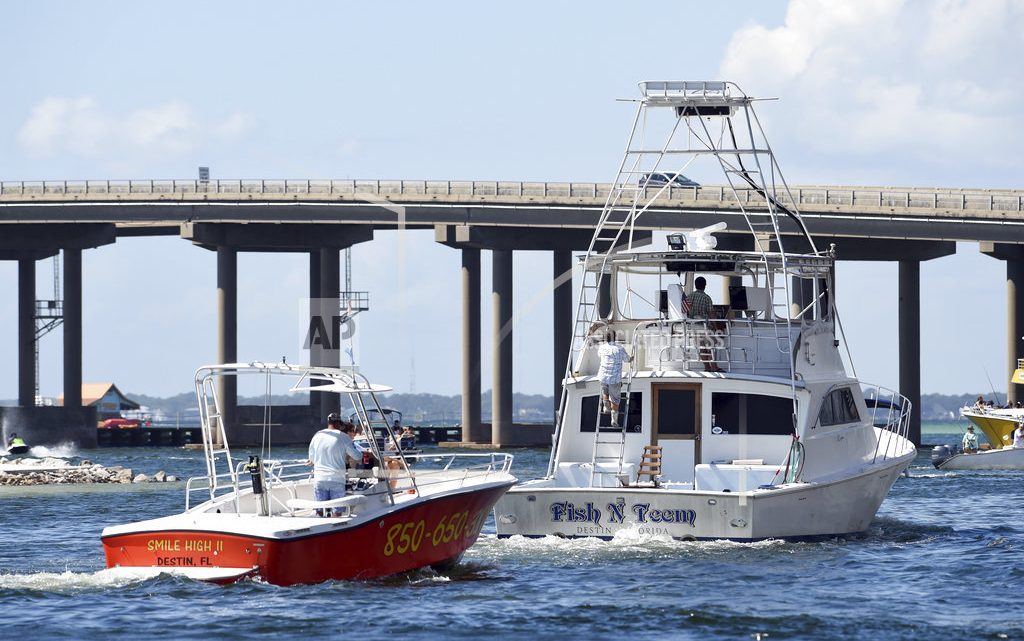Hurricane Michael gains strength on course for north Florida
By JENNIFER KAY and GARY FINEOUT, Associated Press
MIAMI (AP) — Michael gained new strength over warm tropical waters amid fears it would swiftly intensify into a major hurricane before striking Florida’s northeast Gulf Coast, where frantic coastal dwellers are boarding up homes and seeking evacuation routes away from the dangerous storm heading their way.
A hurricane hunter plane that bounced into the swirling eye of Michael off the west tip of Cuba late Monday found wind speeds were rising even as forecasters warned the storm could reach major hurricane status with winds topping 111 mph (179 kph) by Tuesday night. Anticipated landfall is expected Wednesday on the northeast Gulf Coast, where authorities warned of a potentially devastating strike.
By early Tuesday, Michael’s top sustained winds had risen some to 90 mph (144 kph) as it headed north at 12 mph (19 kph). The storm was centered about 425 miles (684 kilometers) south of Apalachicola and 455 miles (732 kilometers) south of Panama City, Florida. Hurricane-force winds extended outward up to 35 miles (56 kilometers) from the core and tropical-storm-force winds out 175 miles (280 kilometers).Hurricane-force winds extended outward up to 35 miles (56 kilometers) from the core and tropical-storm-force winds out 175 miles (280 kilometers). Michael was lashing western Cuba on Monday with heavy rains and strong winds.
Forecasters warned that Michael, now a Category 1 storm, could dump up to a foot (30 centimeters) of rain in western Cuba, potentially triggering flash floods and mudslides in mountain areas.
Disaster agencies in El Salvador, Honduras and Nicaragua reported 13 deaths as roofs collapsed and residents were carried away by swollen rivers. Six people died in Honduras, four in Nicaragua and three in El Salvador. Authorities were also searching for a boy swept away by a river in Guatemala. Most of the rain was blamed on a low-pressure system off the Pacific coast of El Salvador. Hurricane Michael in the Caribbean could have also contributed.
On the Florida Panhandle, Escambia County Sheriff David Morgan bluntly advised residents who choose to ride out the storm that first responders won’t be able to reach them during or immediately after Michael smashes into the coast.
“If you decide to stay in your home and a tree falls on your house or the storm surge catches you and you’re now calling for help, there’s no one that can respond to help you,” Morgan said at a news conference.
Florida Gov. Rick Scott called Michael a “monstrous hurricane” with a devastating potential from high winds, storm surge and heavy rains. He Scott declared a state of emergency for 35 Florida counties from the Panhandle to Tampa Bay, activated hundreds of Florida National Guard members and waived tolls to encourage those near the coast to evacuate inland.
He also warned caregivers at north Florida hospitals and nursing homes to do all possible to assure the safety of the elderly and infirm. Following Hurricane Irma last year, 14 people died when a South Florida nursing home lost power and air conditioning.
“If you’re responsible for a patient, you’re responsible for the patient. Take care of them,” he said.
In the small Panhandle city of Apalachicola, Mayor Van Johnson Sr. said the 2,300 residents are frantically preparing for a major hurricane strike that could be unlike any seen there in decades. Many filled sandbags and boarded up homes. Residents also lined up to buy gas and groceries even as evacuations — both voluntary and mandatory — were expected to pick up the pace Tuesday.
“We’re looking at a significant storm with significant impact, possibly greater than I’ve seen in my 59 years of life,” Johnson said of the city, straddling the shore of Apalachicola Bay, a Gulf of Mexico inlet that reaps about 90 percent of Florida’s oysters.
Mandatory evacuation orders were issued for residents of barrier islands, mobile homes and low-lying coastal areas in Gulf, Wakulla and Bay counties.
In a Facebook post Monday, the Wakulla County Sheriff’s Office said no shelters would be open because Wakulla County shelters were rated safe only for hurricanes with top sustained winds below 111 mph (178 kph). With Michael’s winds projected to be even stronger than that, Wakulla County residents were urged to evacuate inland.
“This storm has the potential to be a historic storm, please take heed,” the sheriff’s office said in the post.
High winds weren’t the only danger. Parts of Florida’s curvy Big Bend could see up to 12 feet (3.7 meters) of storm surge, while Michael also could dump up to a foot (30 centimeters) of rain over some Panhandle communities as it moves inland, forecasters said.
Neighbors in Alabama — the entire state is under an emergency declaration — also were bracing. Alabama Gov. Kay Ivey said she feared widespread power outages and other problems would follow. Forecasters also warned spinoff tornadoes would also be a threat.
With the storm next entering the eastern part of the Gulf of Mexico, which has warm water and favorable atmospheric conditions, “there is a real possibility that Michael will strengthen to a major hurricane before landfall,” Robbie Berg, a hurricane specialist at the Miami-based storm forecasting hub, wrote in an advisory.
A large mound of sand in Tallahassee was whittled down to a small pile within hours Monday as residents filled sandbags against potential flooding.
Tallahassee Mayor Andrew Gillum, Florida’s Democratic nominee for governor, filled sandbags with residents and urged residents of the state capital city to finish up emergency preparations quickly. Local authorities fear power outages and major tree damage from Michael.
“Today it is about life and safety,” Gillum said. “There’s nothing between us and this storm but warm water and I think that’s what terrifies us about the potential impacts.”
___
Fineout reported from Tallahassee, Florida.











No Comment